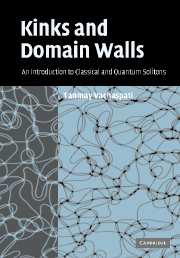Book contents
- Frontmatter
- Contents
- Preface
- 1 Classical kinks
- 2 Kinks in more complicated models
- 3 Interactions
- 4 Kinks in quantum field theory
- 5 Condensates and zero modes on kinks
- 6 Formation of kinks
- 7 Dynamics of domain walls
- 8 Gravity and cosmology of domain walls
- 9 Kinks in the laboratory
- Appendix A Units, numbers and conventions
- Appendix B SU(N) generators
- Appendix C Solution to a common differential equation
- Appendix D Useful operator identities
- Appendix E Variation of the determinant
- Appendix F Summary of cosmological equations
- References
- Index
4 - Kinks in quantum field theory
- Frontmatter
- Contents
- Preface
- 1 Classical kinks
- 2 Kinks in more complicated models
- 3 Interactions
- 4 Kinks in quantum field theory
- 5 Condensates and zero modes on kinks
- 6 Formation of kinks
- 7 Dynamics of domain walls
- 8 Gravity and cosmology of domain walls
- 9 Kinks in the laboratory
- Appendix A Units, numbers and conventions
- Appendix B SU(N) generators
- Appendix C Solution to a common differential equation
- Appendix D Useful operator identities
- Appendix E Variation of the determinant
- Appendix F Summary of cosmological equations
- References
- Index
Summary
A particle in a classical harmonic oscillator potential, mω2x2/2, has minimum energy when it sits at rest at the bottom of the potential. Then the particle's energy vanishes. The Heisenberg uncertainty principle however modifies this picture for the quantum harmonic oscillator. The particle cannot sit at rest (with definite momentum) at the bottom of the potential (a definite location). Indeed, the quantum zero point motion lifts the ground state energy to ω/2. Further, the excited states of the simple harmonic oscillator are discrete and occur at energies (n + 1/2)ω, n = 0, 1, 2, …
Just as the classical harmonic oscillator is modified by quantum effects, any classical solution to a field theory is also modified by quantum effects. Quantum effects give corrections to the classical kink energy owing to zero point quantum field fluctuations. These quantum corrections are small provided the coupling constant in the model is weak. To “quantize the kink” means to evaluate all the energy levels of the kink (first quantization) and to develop a framework for doing quantum field theory in a kink background. This involves identifying all excitations in the presence of the kink and their interactions. The field theory of the excitations in the non-trivial background of the kink is akin to second quantization. Finally, one would also like to describe the creation and annihilation of kinks themselves by suitable kink creation and annihilation operators. This would be the elusive third quantization.
Initially we calculate the leading order quantum corrections to the energy of the Z2 and sine-Gordon kinks. As these two examples illustrate, the precise value of the quantum correction depends on the exact model and kink under consideration.
- Type
- Chapter
- Information
- Kinks and Domain WallsAn Introduction to Classical and Quantum Solitons, pp. 50 - 72Publisher: Cambridge University PressPrint publication year: 2006



